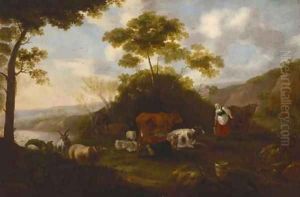Jacob Gerritsz. Von Bemmel Paintings
Jacob Gerritsz. Cuyp was a Dutch Golden Age painter born in Dordrecht in 1628. Notably, he is often confused with Jacob Gerritsz. Van Bemmel due to the similarity in naming, but it's important to distinguish between the two. Jacob Gerritsz. Cuyp was part of a family of artists, with his father, Gerrit Cuyp, being a glass painter, and his more famous son, Aelbert Cuyp, becoming one of the leading Dutch landscape painters. Jacob Gerritsz. Cuyp's contribution to art, however, is significant in its own right, especially in the realm of portrait painting and religious subjects.
Jacob Gerritsz. Cuyp's work is characterized by its careful attention to detail, vibrant colors, and the skillful use of light, which would greatly influence his son Aelbert's work. He was a versatile artist, not only painting portraits and religious scenes but also delving into genre painting and landscapes. His portraits, in particular, are noted for their sensitivity and the detailed depiction of clothing and accessories, reflecting the status and personality of his sitters.
Cuyp's religious paintings are marked by a dynamic expressiveness, bringing biblical stories to life with a vivid sense of realism. These works were well-received in his time, contributing to his reputation and success as an artist. Despite the overshadowing fame of his son Aelbert in later centuries, Jacob's work remains an important part of the Dutch Golden Age's artistic legacy.
Throughout his career, Jacob Gerritsz. Cuyp was active in the artistic community of Dordrecht, where he spent most of his life. He was a member of the Guild of Saint Luke, a common affiliation for artists of the time, which allowed him to sell his works and take on apprentices. His influence extended through his teaching, shaping the next generation of artists in Dordrecht and beyond.
Jacob Gerritsz. Cuyp passed away in 1673 in Dordrecht. His legacy is preserved in the collections of major museums around the world, where his works continue to be studied and admired for their beauty and historical value. Through his contributions to Dutch art, Jacob Gerritsz. Cuyp played a part in the rich tapestry of the Golden Age, leaving a lasting impact that endures to this day.
